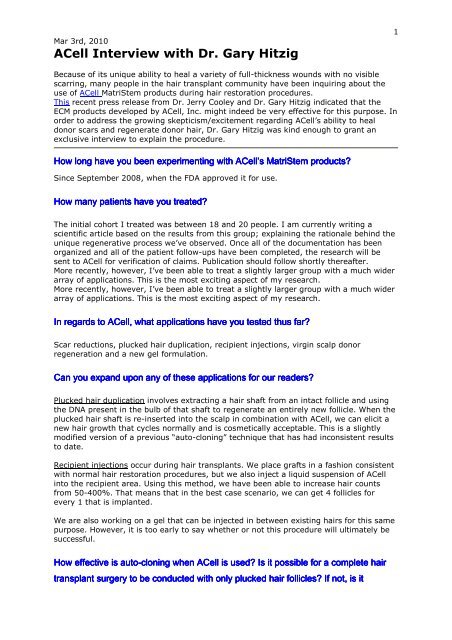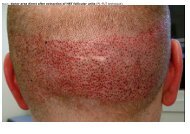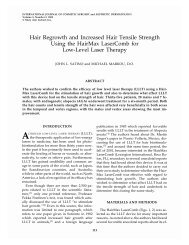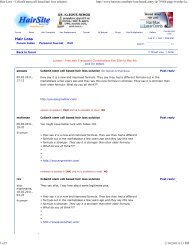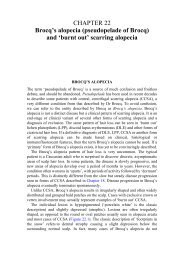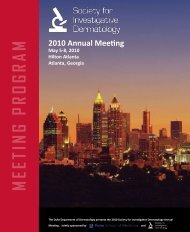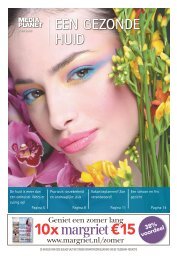ACell Interview with Dr. Gary Hitzig - HairSite.com
ACell Interview with Dr. Gary Hitzig - HairSite.com
ACell Interview with Dr. Gary Hitzig - HairSite.com
You also want an ePaper? Increase the reach of your titles
YUMPU automatically turns print PDFs into web optimized ePapers that Google loves.
Mar 3rd, 2010<br />
<strong>ACell</strong> <strong>Interview</strong> <strong>with</strong> <strong>Dr</strong>. <strong>Gary</strong> <strong>Hitzig</strong><br />
1<br />
Because of its unique ability to heal a variety of full-thickness wounds <strong>with</strong> no visible<br />
scarring, many people in the hair transplant <strong>com</strong>munity have been inquiring about the<br />
use of <strong>ACell</strong> MatriStem products during hair restoration procedures.<br />
This recent press release from <strong>Dr</strong>. Jerry Cooley and <strong>Dr</strong>. <strong>Gary</strong> <strong>Hitzig</strong> indicated that the<br />
ECM products developed by <strong>ACell</strong>, Inc. might indeed be very effective for this purpose. In<br />
order to address the growing skepticism/excitement regarding <strong>ACell</strong>’s ability to heal<br />
donor scars and regenerate donor hair, <strong>Dr</strong>. <strong>Gary</strong> <strong>Hitzig</strong> was kind enough to grant an<br />
exclusive interview to explain the procedure.<br />
How long have you been experimenting <strong>with</strong> <strong>ACell</strong>’s MatriStem products?<br />
Since September 2008, when the FDA approved it for use.<br />
How many patients have you treated?<br />
The initial cohort I treated was between 18 and 20 people. I am currently writing a<br />
scientific article based on the results from this group; explaining the rationale behind the<br />
unique regenerative process we’ve observed. Once all of the documentation has been<br />
organized and all of the patient follow-ups have been <strong>com</strong>pleted, the research will be<br />
sent to <strong>ACell</strong> for verification of claims. Publication should follow shortly thereafter.<br />
More recently, however, I’ve been able to treat a slightly larger group <strong>with</strong> a much wider<br />
array of applications. This is the most exciting aspect of my research.<br />
More recently, however, I’ve been able to treat a slightly larger group <strong>with</strong> a much wider<br />
array of applications. This is the most exciting aspect of my research.<br />
In regards to <strong>ACell</strong>, what applications have you tested thus far?<br />
Scar reductions, plucked hair duplication, recipient injections, virgin scalp donor<br />
regeneration and a new gel formulation.<br />
Can you expand upon any of these applications for our readers?<br />
Plucked hair duplication involves extracting a hair shaft from an intact follicle and using<br />
the DNA present in the bulb of that shaft to regenerate an entirely new follicle. When the<br />
plucked hair shaft is re-inserted into the scalp in <strong>com</strong>bination <strong>with</strong> <strong>ACell</strong>, we can elicit a<br />
new hair growth that cycles normally and is cosmetically acceptable. This is a slightly<br />
modified version of a previous “auto-cloning” technique that has had inconsistent results<br />
to date.<br />
Recipient injections occur during hair transplants. We place grafts in a fashion consistent<br />
<strong>with</strong> normal hair restoration procedures, but we also inject a liquid suspension of <strong>ACell</strong><br />
into the recipient area. Using this method, we have been able to increase hair counts<br />
from 50-400%. That means that in the best case scenario, we can get 4 follicles for<br />
every 1 that is implanted.<br />
We are also working on a gel that can be injected in between existing hairs for this same<br />
purpose. However, it is too early to say whether or not this procedure will ultimately be<br />
successful.<br />
How effective is auto-cloning when <strong>ACell</strong> is used? Is it possible for a <strong>com</strong>plete hair<br />
transplant surgery to be conducted <strong>with</strong> only plucked hair follicles? If not, is it
practical to assume that auto-cloning could be used as an adjunct to “thicken up” a<br />
previous transplant?<br />
2<br />
I don’t know. It would be quite tedious. It is more practical to do a transplant first, and<br />
then increase density <strong>with</strong> injections. This would be more ideal. I should note that this is<br />
still experimental, however.<br />
Has the <strong>com</strong>pany been supportive of this process?<br />
Yes, <strong>ACell</strong> has been extremely helpful during this stage of research and experimentation.<br />
The <strong>com</strong>pany understands that if we knew the answer to every question, we wouldn’t be<br />
sitting here trying to figure it all out. Research starts <strong>with</strong> learning.<br />
Think of it like this: Was Follicular Unit Extraction effective at first? No, it had its share of<br />
pros and cons. But these things are only really realized over time.<br />
Of course it would be preferable to carry out these studies in secret, but we recognize<br />
that some people are really deeply affected by the scarring associated <strong>with</strong> prior hair<br />
transplant procedures. Like anyone else, I don’t want to give people sub-par results and I<br />
don’t want to let people down <strong>with</strong> false hopes. Nevertheless, I also don’t want to keep<br />
this a secret if it can potentially help a large population of people. In choosing this path, I<br />
also chose to take personal responsibility for all of the criticism that manifests. I’m fine<br />
<strong>with</strong> that.<br />
Having said this, expectations MUST BE OBJECTIVE. We have very clear consent forms.<br />
We do not recruit people that expect something we cannot provide. We are trying our<br />
best, and we do have very promising preliminary results. But, like they say, “prior<br />
successes are not an indication of future results.” Wound healing and regeneration is<br />
quite a variable process. <strong>ACell</strong> understands this, we understand this, and our patients<br />
understand this.<br />
Why do you think this process works?<br />
This is something I plan on extrapolating upon <strong>with</strong> the current article I’m working on.<br />
It’s pretty technical, but I can summarize it like this: Essentially, all tissue has an<br />
extracellular matrix (ECM). I like to call it “mother nature’s biological scaffold.” It’s a<br />
production of a chemical that each tissue possesses for its specific phenotype. ECM is the<br />
primary tool for cellular attachment, production and final differentiation of tissue.<br />
Certain areas of the body (like the bladder and small intestine) have a much higher<br />
concentrated and evolved form of ECM. Also, only certain organs have a basement<br />
membrane along <strong>with</strong> their ECM. This basement membrane is critical for healing after<br />
wound injury. It plays an important role in remodeling tissue during the healing process.<br />
<strong>ACell</strong> provides this “scaffolding” to areas of the body that are obviously not able to<br />
regenerate themselves.<br />
To reconstruct new tissue you need three things: 1) Cells, 2) scaffolds and 3) bioactive<br />
molecules. <strong>ACell</strong>’s proprietary ECM provides all of these and organizes the migration and<br />
final differentiation of epidermal cells. “Line up, differentiate, prevent the default (scar<br />
tissue).”<br />
After the host cells are recruited, the scaffold gets broken apart and disintegrated, then<br />
the new stem cells migrate to the area and replace it <strong>with</strong> new, host-derived tissue.<br />
This has already been demonstrated in many human and animal studies. More recently,<br />
it’s been quite successful at repair and subsequent reconstruction of dermal structures in<br />
hundreds of thousands of patients.


